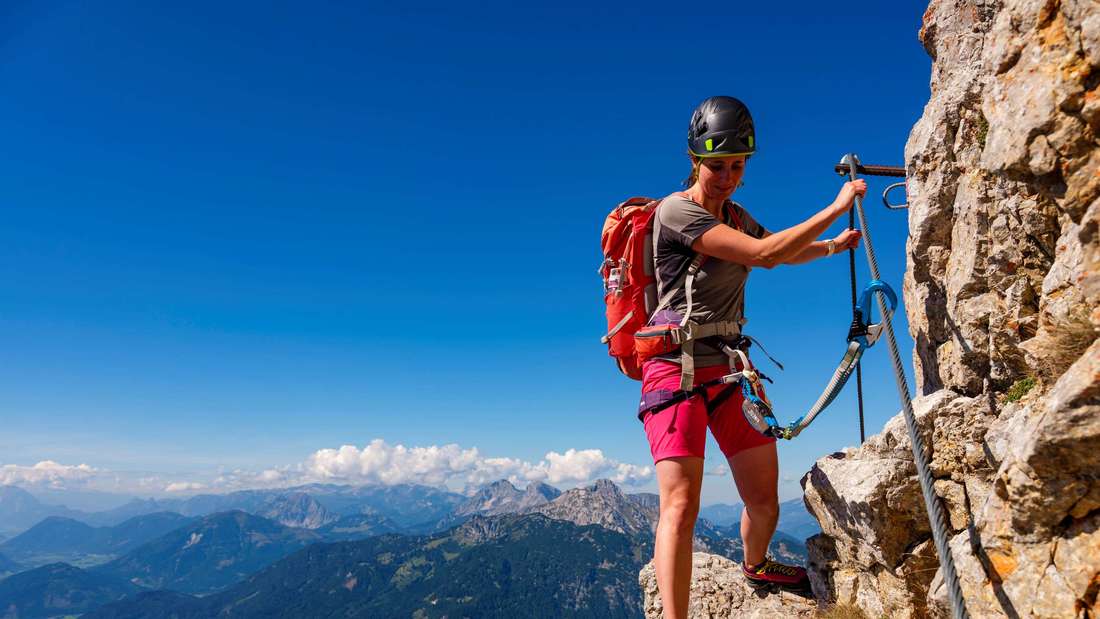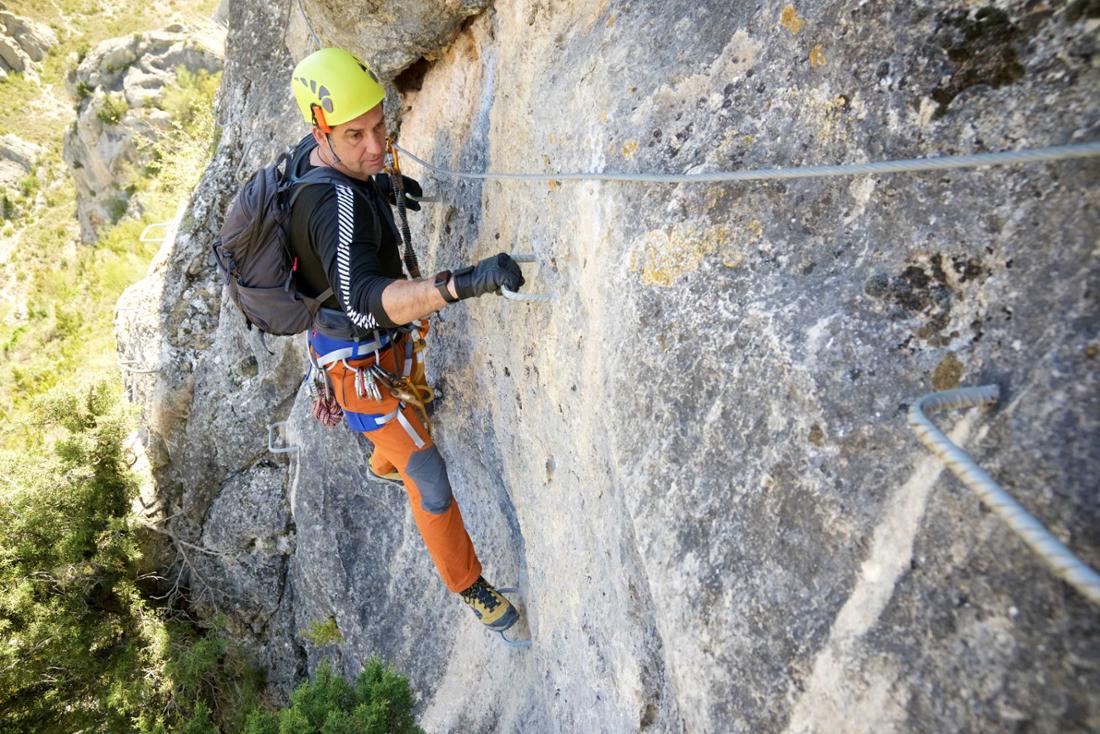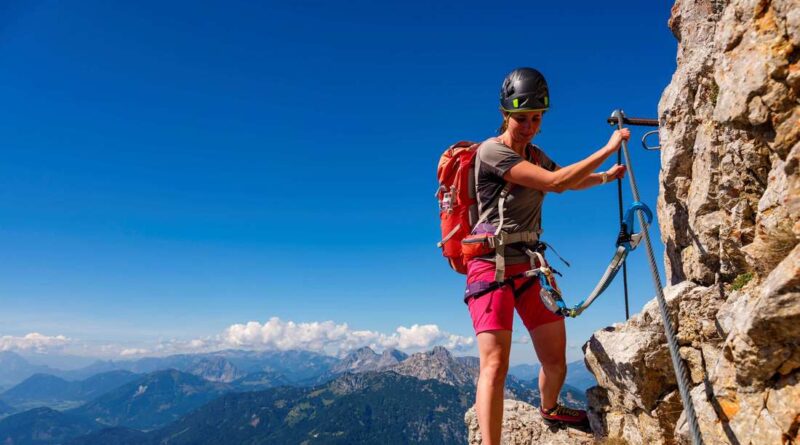What do you need for via ferrata? Equipment, exercise…

In the past, via ferratas were used to reach the summit safely. Today it has become a game in itself. What you need to know about fitness, technology, equipment and tour planning – all the information at a glance.
Walking where no one dares to go, lots of air beneath you and a wide view – a via ferrata can offer all of this. Halfway secured (why halfway, more below) you climb a wire rope on a via ferrata. Internationally, the Italian name Via Ferrata, which translates as “Iron Road”, is used.
In the past, the goal was to use the rope as an aid to reach the summit more safely today, via ferrata is a sport in itself, as noted by the German Alpine Association (DAV). Sports via ferratas are no longer the case that you go up, but Howi.e. about spreading.
Via ferratas require strength, mobility and mental strength and have fun features such as suspension bridges and stairs. Especially when the easy route leads to the goal and is a sporting challenge, it is called via ferrata. Such ferratas are not only found in mountains, but also in reservoirs, houses, bridges and old open mines.
The difficulty of via ferrata climbing is much lower than rope climbing. However, via ferratas can be incredibly dangerous for those who don’t know themselves well or who ignore their abilities. In May 2024, the mountain rescue service in Salzburger Land had to extricate a father and daughter from the wall because they had climbed too hard and could no longer get out. first because they were tired.
Types of via ferrata
Insurance policy: A very difficult climbing route protected only by wire rope in difficult, exposed areas.
Alpine via ferrata: A continuous rope usually leads to the top in a place where there is a risk of falling. The via ferrata set is a tie here.
Sports via ferrata: Ropes, steel wires and fun things like rope bridges and ladders travel the steep terrain. The focus is on the challenge of the games.
On the via ferrata scale: The overall score is always based on the hardest part, regardless of length. In Germany, via ferratas are usually rated from A to F according to Kurt Schall in Switzerland, the Hüsler scale (K1 to K6) is also used. In Italy and France there is a scale from F (facile = easy) to ED (extrement difficile = very difficult).
Difficulty levels according to the volume scale: Category A ca ferratas are the easiest routes, but technically more demanding than the red climbing route. The B mountains run on a steep and windy terrain. At C being steeper, more exposure and climbing experience as well as strength and endurance are required. In problem D, the overhangs are increased and there are fewer stepping aids.
Required physical and mental exercise and technique

False desire has no place in the mountains! Even those who consider themselves very strong should not underestimate ferratas. In addition to physical fitness, there is also mental stress. Since you can’t fall straight, this tests you to reach your fall limit. At the same time, this knowledge can cause stress and fear Restrictions take the lead. Compared to other mountain sports, these mental obstacles occur more often in the via ferratas, as shown by the DAV accident statistics from 2022. Now nothing can go forward or backward and mountain rescue service must come.
So it’s better first start easygain experience and gradually improve when you feel comfortable. It is easier to go via ferratas (A and B) and they are also fun if you can enjoy the journey, the view and nature with a relaxed head and sufficient energy reserves. Difficulty levels are also a rough guide, and climbing similar levels doesn’t have to be equally difficult. The 500 meter long B route requires more endurance than via ferrata with the harder D section. This requires more energy. When planning a visit, you should not only take into account the difficulty of the via ferrata, but also consider its length as well as the way of approach and descent. This all comes down to the required practice and time planning. You can find out how to plan a good trip here.
To mentally prepare for via ferrata, you can climb a rope in a climbing hall or get used to the height of the high ropes and gain confidence in the material. This also increases strength and endurance, which are important for via ferratas. Generally, this works to conserve energy climbing as much as possible.
Couples Basic technology:
- Keep your arms long
- Put more weight on your feet
- Use speed
- If you are pushing up, connect your elbow to the wire rope
A full body workout for strength and endurance

In less than half an hour you train strength and endurance. Here you can download the full body workout for free as a PDF.
The right stuff

Compared to climbing ropes, via ferrata requires very little equipment. In Alpine resorts you can usually rent almost anything without spending a few hundred euros. The most important tools are Helm, Climbing rope and On a via ferrata set.
The helmet protects against falling stones and hitting the head during a fall or while walking. As a safety helmet for climbing, it must meet the standards of EN 12492. The via ferrata set has an energy absorber and two safety straps, each with a hand carabiner, which you connect to the wire. As the name suggests, the “shock absorber” prevents falls by expanding the area of the fall so that, in the best cases, there are no life-threatening injuries. The via ferrata set is only an emergency system and must be replaced after a fall!
It also makes sense to have a short fuse/Rastschlinge/ Have an opening in the belt so that you can sit on the belt in an orderly fashion for breaks. You wear it on your feet Bergschuhedepending on the taste and needs of the road, hard or easy, as a low shoe or ankle. Sneakers don’t go. Gloves protect your hands, give you more grip and protect them from exposed wire strands. There are other via ferrata gloves, but work gloves are also good.
Children, obese and weak people can use a length of 20 to 30 meters Rope is further protected to prevent falls. However, anyone who gives birth must know the proper techniques for belaying from climbing ropes. Read here what else you should have in your travel bag. You can download the day tripper packing list here for free as a PDF.
Required knowledge
Before the trip: Proper tour planning is very important for via ferratas. First of all, you have to properly assess yourself and your technical skills in mountaineering and trekking. How long is the trip and how high is it? Are there emergency exits or other routes? How dangerous would the fall be and how difficult would the mountain rescue be? Do I have the right tools? Even with the right equipment, a fall can have serious consequences. The via ferrata set and helmet prevent the worst, but if you fall you can still injure yourself to the point where you can no longer climb and have to call the mountain rescue service. Rescue can be very complicated and expensive. Weather and current conditions also play an important role. During thunderstorms, wire ropes act as lightning rods, when it rains, the air cools you down and the sun can lead to dehydration. It can still snow in the spring. You can find out about the current conditions on the alpenvereinaktiv.com website. If you are not sure, you can take a basic course via ferrata – for example with DAV.
During the trip: Don’t fall off the via ferrata! The equipment is only an emergency system. You are permanently secured to the wire rope with at least one carabiner and you can quickly hang it between the wire rope anchors. Never hang the carabiners through the rope loop on the harness, as this will disable the shock absorber. Keep at least part of the wire ropes away from the climbers, be considerate of each other and try not to kick rocks. You constantly check the weather, your schedule, and your physical and mental state. If necessary, make an emergency exit or change routes.
After the trip: When you reach the valley or starting point, you think about the journey. Did I feel comfortable? Were there any difficult passages and why were they difficult for me? How mentally and physically challenging was this trip for me? You can make decisions from this for the next tour plan and maybe you can try to try harder via ferrata if everything went well.
Looking to boost your fitness for the mountains? Then download the PDF training plan “Fit for Hiking” for free in the PDF library.
Great on German ferratas
The website klettersteig.de lists 285 via ferratas for Germany. A good topoi can be found on the website bergstieg.com, which offers 86 German via ferratas. Germany’s toughest climb in the Odenwald: The Karola via ferrata runs in category F to a 60 meter high wall. There are more tips for visiting the Odenwald here.
If you want to climb the highest mountain in Germany, you can take one of the two via ferratas to the Zugspitze. The Stopselzieh via ferrata (A/B) is from Tyrol – this trip is considered short and short, but still difficult with a walk of about five hours. The trip takes seven hours to the top via the Höllental, a glacier with the same name as via ferrata (B/C). In addition to climbing via ferrata, knowledge about crevasse rescue is also necessary. That’s why it’s only for the best professionals, like these six via ferratas.
Another great alpine via ferrata is the Vulkaneifel in Rhineland-Palatinate. On the Manderscheider Burgenklettersteig you climb in an unusual way along the Lieser, and you can choose how hard you want it to be and go out in between. There are also many good via ferratas in Franconian Switzerland, in the Elbe Sandstone Mountains, the Black Forest, the Middle Rhine and the Allgäu.
Note: Before embarking on a journey, find out about the level of the problem, current conditions and requirements. For travel destinations, opening times and important information should be checked in advance.
#ferrata #Equipment #exercise..
